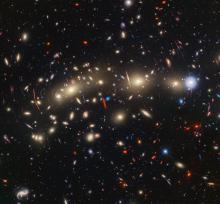Listen to today's episode of StarDate on the web the same day it airs in high-quality streaming audio without any extra ads or announcements. Choose a $8 one-month pass, or listen every day for a year for just $30.
You are here
Smith’s Cloud
In 30 million years or so, the Milky Way Galaxy may stage a spectacular fireworks display. It could give birth to hundreds of thousands of stars in just a few million years — the result of a massive collision.
Smith’s Cloud is falling toward the Milky Way’s disk. The cloud is about 10,000 light-years long. To get a sense of how big that is, consider that it spans about 20 times the width of the full Moon as seen from Earth, even though it’s maybe 40,000 light-years away.
Astronomers are still trying to figure out where the cloud came from. A study a few years ago used Hubble Space Telescope to examine its chemistry. From that, scientists suggested that it came from the outer regions of the Milky Way’s disk — perhaps blasted away by a cluster of exploding stars about 70 million years ago.
Today, it’s falling back toward the disk — toward the outer edge of the Perseus spiral arm. When it hits, it’ll slam into other clouds of gas and dust. That will squeeze all the clouds, causing them to split into clumps. The clumps then will collapse to form new stars — the equivalent of perhaps a million stars the mass of the Sun.
For now, Smith’s Cloud is in the constellation Aquila, the eagle, which is low in the west-southwest at nightfall. Its brightest star, Altair, marks the left point of the bright Summer Triangle. Smith’s Cloud is so cold and dark that it’s visible only to radio telescopes — to the lower left of Altair.
Script by Damond Benningfield





